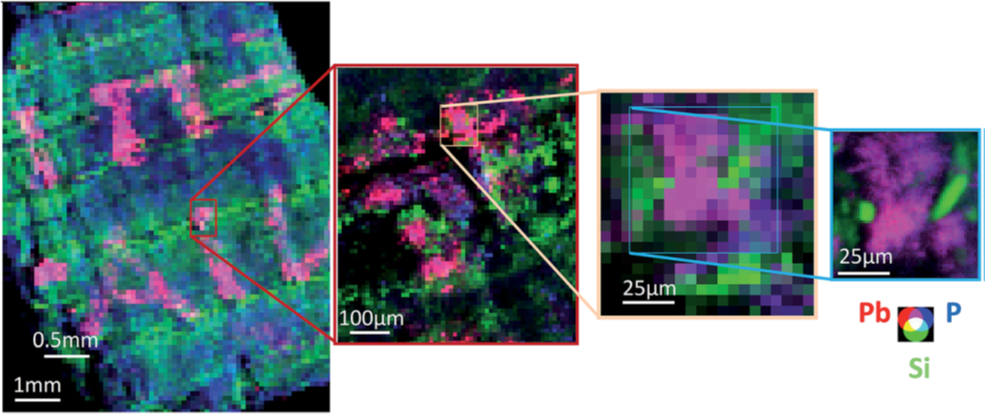Papyrus
Introduction of metals in inks used on papyri
ID21 is certainly not suitable for deciphering entire pages as can be done at other X-ray facilities. This is due to the limited size of samples that can be analysed in the microscopes (~2.5 cm max). Instead, the ID21 instruments can be used to probe ink with a zooming approach from the letter scale (with a beam of ~0.3mm) down to the ink particle scale (with a sub-micrometric beam). This can give clues about the elemental and chemical composition of ink and in particular the progressive introduction of metals (such as copper, lead, iron) in ink.

 |
Thomas Christiansen, M. Cotte, W. de Nolf, E. Mouro, J. Reyes-Herrera, S. de Meyer, F. Vanmeert, N.Salvadó, V. Gonzalez, P. Erik Lindelof, K. Mortensen, K. Ryholt, K. Janssens and S. Larsen, "Insights into the composition of ancient Egyptian red and black inks on papyri achieved by synchrotron-based microanalyses", (2020). |
A hitherto unknown composition is highlighted in the red and black inks preserved on ancient Egyptian papyri from the Roman period (circa 100 to 200 CE). Synchrotron-based macro–X-ray fluorescence (XRF) mapping brings to light the presence of iron (Fe) and lead (Pb) compounds in the majority of the red inks inscribed on 12 papyrus fragments from the Tebtunis temple library. The iron-based compounds in the inks can be assigned to ocher, notably due to the colocalization of Fe with aluminum, and the detection of hematite (Fe2O3) by micro–X-ray diffraction. Using the same techniques together with micro-Fourier transform infrared spectroscopy, Pb is shown to be associated with fatty acid phosphate, sulfate, chloride, and carboxylate ions. Moreover, micro-XRF maps reveal a peculiar distribution and colocalization of Pb, phosphorus (P), and sulfur (S), which are present at the micrometric scale resembling diffused “coffee rings” surrounding the ocher particles imbedded in the red letters, and at the submicrometric scale concentrated in the papyrus cell walls. A similar Pb, P, and S composition was found in three black inks, suggesting that the same lead components were employed in the manufacture of carbon-based inks. Bearing in mind that pigments such as red lead (Pb3O4) and lead white (hydrocerussite [Pb3(CO3)2(OH)2] and/or cerussite [PbCO3]) were not detected, the results presented here suggest that the lead compound in the ink was used as a drier rather than as a pigment. Accordingly, the study calls for a reassessment of the composition of lead-based components in ancient Mediterranean pigments.
|
T. Christiansen, M. Cotte, R. Loredo-Portales, P. E. Lindelof, K. Mortensen, K. Ryholt and S. Larsen, "The nature of ancient Egyptian copper-containing carbon inks is revealed by synchrotron radiation based X-ray microscopy", Scientific Reports, 7, 15346 (2017). |
For the first time it is shown that carbon black inks on ancient Egyptian papyri from different time periods and geographical regions contain copper. The inks have been investigated using synchrotron-based micro X-ray fluorescence (XRF) and micro X-ray absorption near-edge structure spectroscopy (XANES) at the European Synchrotron Radiation Facility (ESRF). The composition of the copper-containing carbon inks showed no significant differences that could be related to time periods or the geographical locations. This renders it probable that the same technology for ink production was used throughout Egypt for a period spanning at least 300 years. It is argued that the black pigment material (soot) for these inks was obtained as by-products of technical metallurgy. The copper (Cu) can be correlated with the following three main components: cuprite (Cu2O), azurite (Cu3[CO3]2[OH]2) and malachite (Cu2CO3[OH]2).
|
E. Brun, M. Cotte, J. Wright, M. Ruat, P. Tack, L. Vincze, C. Ferrero, D. Delattre and V. Mocella, "Revealing metallic ink in Herculaneum papyri", Proceedings of the National Academy of Sciences, 113.14, 3751-3754 (2016). |
Writing on paper is essential to civilization, as Pliny the Elder remarks in his Natural History, when he describes the various types of papyri, the method of manufacturing them, and all that concerns writing materials in the mid-first century AD. For this reason, a rigorous scientific study of writing is of fundamental importance for the historical understanding of ancient societies. We show that metallic ink was used several centuries earlier than previously thought. In particular, we found strong evidence that lead was intentionally used in the ink of Herculaneum papyri and discuss the possible existence of ruled lines traced on the papyrus texture. In addition, the metallic concentrations found in these fragments deliver important information in view of optimizing future computed tomography (CT) experiments on still-unrolled Herculaneum scrolls to improve the readability of texts in the only surviving ancient Greco-Roman library.
|
P. Tack, M. Cotte, S. Bauters, E. Brun, D. Banerjee, W. Bras, C. Ferrero, D. Delattre, V. Mocella and L. Vincze, "Tracking ink composition on Herculaneum papyrus scrolls: quantification and speciation of lead by X-ray based techniques and Monte Carlo simulations", Scientific reports, 6, 20763 (2016). |
The writing in carbonized Herculaneum scrolls, covered and preserved by the pyroclastic events of the Vesuvius in 79 AD, was recently revealed using X-ray phase-contrast tomography, without the need of unrolling the sensitive scrolls. Unfortunately, some of the text is difficult to read due to the interference of the papyrus fibers crossing the written text vertically and horizontally. Recently, lead was found as an elemental constituent in the writing, rendering the text more clearly readable when monitoring the lead X-ray fluorescence signal. Here, several hypotheses are postulated for the origin and state of lead in the papyrus writing. Multi-scale X-ray fluorescence micro-imaging, Monte Carlo quantification and X-ray absorption microspectroscopy experiments are used to provide additional information on the ink composition, in an attempt to determine the origin of the lead in the Herculaneum scrolls and validate the postulated hypotheses.



